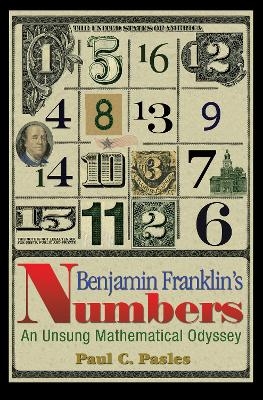
Benjamin Franklin's Numbers
An Unsung Mathematical Odyssey
Seiten
2007
Princeton University Press (Verlag)
978-0-691-12956-3 (ISBN)
Princeton University Press (Verlag)
978-0-691-12956-3 (ISBN)
Revealing the mathematical side of Benjamin Franklin, this book explains the mathematics behind Franklin's popular "Poor Richard's Almanac", which featured such things as population estimates and a host of mathematical digressions. It includes optional math problems that challenge readers to match wits with the Founding Father himself.
Few American lives have been as celebrated--or as closely scrutinized--as that of Benjamin Franklin. Yet until now Franklin's biographers have downplayed his interest in mathematics, at best portraying it as the idle musings of a brilliant and ever-restless mind. In Benjamin Franklin's Numbers, Paul Pasles reveals a side of the iconic statesman, scientist, and writer that few Americans know--his mathematical side. In fact, Franklin indulged in many areas of mathematics, including number theory, geometry, statistics, and economics. In this generously illustrated book, Pasles gives us the first mathematical biography of Benjamin Franklin. He draws upon previously unknown sources to illustrate Franklin's genius for numbers as never before. Magic squares and circles were a lifelong fascination of Franklin's. Here, for the first time, Pasles gathers every one of these marvelous creations together in one place. He explains the mathematics behind them and Franklin's hugely popular Poor Richard's Almanac, which featured such things as population estimates and a host of mathematical digressions.
Pasles even includes optional math problems that challenge readers to match wits with the bespectacled Founding Father himself. Written for a general audience, this book assumes no technical skills beyond basic arithmetic. Benjamin Franklin's Numbers is a delightful blend of biography, history, and popular mathematics. If you think you already know Franklin's story, this entertaining and richly detailed book will make you think again.
Few American lives have been as celebrated--or as closely scrutinized--as that of Benjamin Franklin. Yet until now Franklin's biographers have downplayed his interest in mathematics, at best portraying it as the idle musings of a brilliant and ever-restless mind. In Benjamin Franklin's Numbers, Paul Pasles reveals a side of the iconic statesman, scientist, and writer that few Americans know--his mathematical side. In fact, Franklin indulged in many areas of mathematics, including number theory, geometry, statistics, and economics. In this generously illustrated book, Pasles gives us the first mathematical biography of Benjamin Franklin. He draws upon previously unknown sources to illustrate Franklin's genius for numbers as never before. Magic squares and circles were a lifelong fascination of Franklin's. Here, for the first time, Pasles gathers every one of these marvelous creations together in one place. He explains the mathematics behind them and Franklin's hugely popular Poor Richard's Almanac, which featured such things as population estimates and a host of mathematical digressions.
Pasles even includes optional math problems that challenge readers to match wits with the bespectacled Founding Father himself. Written for a general audience, this book assumes no technical skills beyond basic arithmetic. Benjamin Franklin's Numbers is a delightful blend of biography, history, and popular mathematics. If you think you already know Franklin's story, this entertaining and richly detailed book will make you think again.
Paul C. Pasles is associate professor of mathematical sciences at Villanova University.
Preface ix Chapter 1: The Book Franklin Never Wrote 1 Chapter 2: A Brief History of Magic 20 Chapter 3: Almanacs and Assembly 61 Interlude: Philomath Math 83 Chapter 4: Publisher, Theorist, Inventor, Innovator 87 Chapter 5: A Visit to the Country 117 Chapter 6: The Mutation Spreads (Adventures Among the English) 141 Chapter 7: Circling the Square 158 Chapter 8: Newly Unearthed Discoveries 191 Chapter 9: Legacy 226 Acknowledgements 243 Appendix 245 Index 253
| Erscheint lt. Verlag | 4.11.2007 |
|---|---|
| Zusatzinfo | 9 color plates. 50 halftones. 52 line illus. |
| Verlagsort | New Jersey |
| Sprache | englisch |
| Maße | 152 x 235 mm |
| Gewicht | 510 g |
| Themenwelt | Mathematik / Informatik ► Mathematik ► Allgemeines / Lexika |
| Mathematik / Informatik ► Mathematik ► Geschichte der Mathematik | |
| ISBN-10 | 0-691-12956-8 / 0691129568 |
| ISBN-13 | 978-0-691-12956-3 / 9780691129563 |
| Zustand | Neuware |
| Haben Sie eine Frage zum Produkt? |
Mehr entdecken
aus dem Bereich
aus dem Bereich


